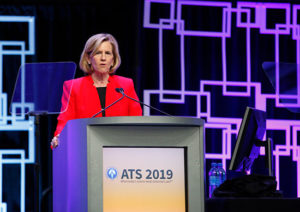Polly Parsons, MD, ATSF, president of the American Thoracic Society, opened the 115th ATS International Conference Saturday afternoon by welcoming Mary E. Klotman, dean of the Duke University School of Medicine and vice chancellor for Health Affairs as the guest speaker.

Mary Klotman, MD, addressed how the intersection of diversity in collaboration can yield solutions to big problems.
An NIH funded investigator, Dr. Klotman, MD, focuses on the molecular pathogenesis of HIV-1. She and her team demonstrated that HIV resides in and evolves separately in kidney cells, a critical step in HIV-associated kidney disease. She said 25 years ago there was not much known about the connection between HIV and kidney disease. But today, thanks to input from many different team collaborators, it is all known.
“Teamwork is now a science,” she said. Great solutions can be uncovered to knotty problems by building diverse cognitive teams, not necessarily like-minded individuals from the same background, she added.
“Diverse perspectives really contribute to success,” she said. That includes diversity in perspectives, education, and culture.
One example she gave is MEDx at Duke, a collaboration of members from the Duke Schools of Medicine and Engineering where they developed a device that allows one nurse to turn a patient without getting hurt.
Dr. Klotman said the same principles of team science can be applied to clinical health systems and their academic institutions.
The Deep Care Management Project investigated ways to reduce costs. She said inpatient care accounts for 30 percent of Duke Connected Care total costs with primary admissions representing 90 percent of the cost burden.
By putting unusual teams of clinicians, researchers, data scientists, and health system providers together, she said they were able to take health records of Medicare patients and develop predictive algorithms to reduce unplanned admissions for at-risk patients.
She observed that diverse teamwork is forcing us to “redo” education.
“If we expect our physicians and scientists to work together in teams, we have to train them. We have to refocus within schools, flip the classrooms so time is spent on teamwork.”
To that point, Dr. Parsons spoke about the ATS’s own efforts of improving education.
“Members now expect enhanced access to information, and they thrive with novel learning strategies that rely heavily on technology,” Dr. Parsons said. “And in the even more competitive field of academic medicine, they need additional resources to advance the field of medicine and opportunities to earn academic capital to advance their careers.”
Dr. Parsons addressed the decline in specialists focusing on pediatric pulmonary care and the constant struggles for the scientist all along the pipeline. The ATS is working to address these needs with expanded early career educational opportunities such as The Resident Bootcamp, improved technology and association infrastructure, and the adoption of clear policies covering the areas of diversity, inclusion, and professional conduct.
“While we did have policies in place for some time, these new policies set higher standards and reflect a membership that prizes the extraordinary, not merely the acceptable,” she said.
Moving forward, Dr. Parson encouraged continuing to cultivate the next generation of researchers.
“Ten years ago, we awarded four unrestricted research grants. This past year, we awarded 14. Including MECOR and partner grants, in the 2018 grant cycle, the Foundation awarded 30 research grants totaling more than $1.6 million. For this coming year, the ATS has contributed additional dollars to the foundation to increase the number of unrestricted grants from 14 to 17, and we earmarked significant funds to ensure the program’s future.”
